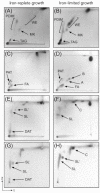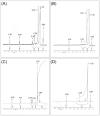Lipid composition and transcriptional response of Mycobacterium tuberculosis grown under iron-limitation in continuous culture: identification of a novel wax ester
- PMID: 17464057
- PMCID: PMC3123377
- DOI: 10.1099/mic.0.2006/004317-0
Lipid composition and transcriptional response of Mycobacterium tuberculosis grown under iron-limitation in continuous culture: identification of a novel wax ester
Abstract
The low level of available iron in vivo is a major obstacle for microbial pathogens and is a stimulus for the expression of virulence genes. In this study, Mycobacterium tuberculosis H37Rv was grown aerobically in the presence of limited iron availability in chemostat culture to determine the physiological response of the organism to iron-limitation. A previously unidentified wax ester accumulated under iron-limited growth, and changes in the abundance of triacylglycerol and menaquinone were also observed between iron-replete and iron-limited chemostat cultures. DNA microarray analysis revealed differential expression of genes involved in glycerolipid metabolism and isoprenoid quinone biosynthesis, providing some insight into the underlying genetic changes that correlate with cell-wall lipid profiles of M. tuberculosis growing in an iron-limited environment.
Figures



Similar articles
-
The influence of reduced oxygen availability on pathogenicity and gene expression in Mycobacterium tuberculosis.Tuberculosis (Edinb). 2004;84(3-4):205-17. doi: 10.1016/j.tube.2003.12.011. Tuberculosis (Edinb). 2004. PMID: 15207490
-
Mycobacterium tuberculosis gene expression profiling within the context of protein networks.Microbes Infect. 2006 Mar;8(3):747-57. doi: 10.1016/j.micinf.2005.09.011. Epub 2006 Jan 18. Microbes Infect. 2006. PMID: 16513384
-
Variable transcriptional adaptation between the laboratory (H37Rv) and clinical strains (S7 and S10) of Mycobacterium tuberculosis under hypoxia.Infect Genet Evol. 2016 Jun;40:21-28. doi: 10.1016/j.meegid.2016.01.007. Epub 2016 Jan 11. Infect Genet Evol. 2016. PMID: 26780642
-
The genetics of cell wall biosynthesis in Mycobacterium tuberculosis.Future Microbiol. 2008 Jun;3(3):299-313. doi: 10.2217/17460913.3.3.299. Future Microbiol. 2008. PMID: 18505396 Review.
-
Extra and intracellular expression of Mycobacterium tuberculosis genes.Tuber Lung Dis. 1998;79(2):91-7. doi: 10.1054/tuld.1998.0010. Tuber Lung Dis. 1998. PMID: 10645446 Review.
Cited by
-
The promoter of Rv0560c is induced by salicylate and structurally-related compounds in Mycobacterium tuberculosis.PLoS One. 2012;7(4):e34471. doi: 10.1371/journal.pone.0034471. Epub 2012 Apr 2. PLoS One. 2012. PMID: 22485172 Free PMC article.
-
Roles of Lipolytic enzymes in Mycobacterium tuberculosis pathogenesis.Front Microbiol. 2024 Jan 29;15:1329715. doi: 10.3389/fmicb.2024.1329715. eCollection 2024. Front Microbiol. 2024. PMID: 38357346 Free PMC article. Review.
-
Delineating transcriptional crosstalk between Mycobacterium avium subsp. paratuberculosis and human THP-1 cells at the early stage of infection via dual RNA-seq analysis.Vet Res. 2022 Sep 13;53(1):71. doi: 10.1186/s13567-022-01089-y. Vet Res. 2022. PMID: 36100945 Free PMC article.
-
Adaptation of Mycobacterium smegmatis to an Industrial Scale Medium and Isolation of the Mycobacterial PorinMspA.Open Microbiol J. 2013 May 17;7:92-8. doi: 10.2174/1874285801307010092. Print 2013. Open Microbiol J. 2013. PMID: 23802026 Free PMC article.
-
Intrabacterial lipid inclusion-associated proteins: a core machinery conserved from saprophyte Actinobacteria to the human pathogen Mycobacterium tuberculosis.FEBS Open Bio. 2023 Dec;13(12):2306-2323. doi: 10.1002/2211-5463.13721. Epub 2023 Nov 15. FEBS Open Bio. 2023. PMID: 37872001 Free PMC article.
References
-
- Alvarez HM, Kalscheuer R, Steinbuchel A. Accumulation and mobilization of storage lipids by Rhodococcus opacus PD630 and Rhodococcus ruber NCIMB 40126. Appl Microbiol Biotechnol. 2000;54:218–223. - PubMed
-
- Bacon J, James BW, Wernisch L, Williams A, Morley KA, Hatch GJ, Mangan JA, Hinds J, Stoker NG, other authors The influence of reduced oxygen availability on pathogenicity and gene expression in Mycobacterium tuberculosis. Tuberculosis (Edinb) 2004;84:205–217. - PubMed
-
- Bono H, Ogata H, Goto S, Kanehisa M. Reconstruction of amino acid biosynthesis pathways from the complete genome sequence. Genome Res. 1998;8:203–210. - PubMed
-
- Cox JS, Chen B, McNeil M, Jacobs WR. Complex lipid determines tissue-specific replication of Mycobacterium tuberculosis in mice. Nature. 1999;402:79–83. - PubMed
-
- Daniel J, Deb C, Dubey VS, Sirakova TD, Abomoelak B, Morbidoni HR, Kolattukudy PE. Induction of a novel class of diacylglycerol acyltransferases and triacylglycerol accumulation in Mycobacterium tuberculosis as it goes into a dormancy-like state in culture. J Bacteriol. 2004;186:5017–5030. - PMC - PubMed
Publication types
MeSH terms
Substances
Grants and funding
LinkOut - more resources
Full Text Sources
Medical
Molecular Biology Databases

